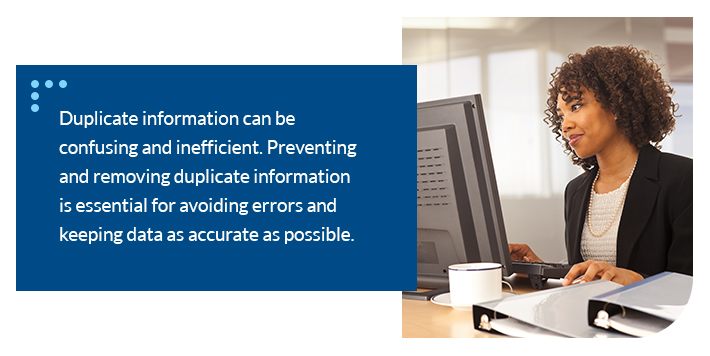
Errors are an unavoidable part of manual data entry. These tasks require employees to add, edit, and verify electronic data.
A team member might update a spreadsheet to reflect the day’s sales figures, type up a transcription of a presentation, or turn a handwritten document into a digital file. Unfortunately, humans are prone to mistakes, so these manual processes will eventually contain errors, which often require more resources to correct. The further along these errors get in your workflow, the more they typically cost.
While manual processes will never achieve perfect data entry, you can minimize mistakes with some targeted techniques. The right data entry automation technology can go even further and help you get closer to an error-free workplace.
Data entry errors come in a few different types, depending on where and how the error occurs:
Different technologies and processes address these issues, so you’ll need a holistic approach to your data entry to avoid them.
From evaluating your employee’s work environment to implementing end-to-end automation, you can dramatically reduce errors through your data entry processes. Here are some of our top suggestions on how to reduce errors and increase quality of work.
Even the best employees are likely to make mistakes if they’re not completely focused. Fatigue, for instance, causes issues like decreased awareness, reduced information-processing ability, absent-mindedness, and a lack of attention.
Focus on creating a work environment that promotes employee health, such as encouraging breaks. Even small changes like comfortable chairs and wristpads can help improve worker health and reduce errors.
One of the most valuable changes you can make to the work environment is maintaining sufficient staffing levels. Rushing your staff to meet unachievable deadlines could lead to more errors. Your team must be appropriately sized for the workload, so you may need to hire more people or implement automation tools to reduce the workload, which we’ll discuss later.
Data validation monitors your data for errors and inconsistencies. This process might check the entered data against certain rules, such as:
Validation is a quick and valuable process that can catch many errors before they cause more significant problems.
Implementing new technology and processes is a great start, but you can always strive for continuous improvement. Track error rates and efficiencies to gain insights into your environment and monitor your team’s success. Look for error-prone areas, such as specific tasks or employees. Then, you can investigate and tweak your approach to ensure high accuracy at all times.

Duplicate information can be confusing and inefficient. Say an employee creates an updated version of a spreadsheet but doesn’t delete the original version. If another team member thinks the outdated version is current, they might make poorly informed decisions from that data. Redundant data could also be the result of unnecessary data entry, such as two workers inputting information from the same document.
Preventing and removing duplicate information is essential for avoiding errors and keeping data as accurate as possible.
Automation tools excel at monotonous, repetitive tasks, so they’re perfect for data entry. You can automate specific tasks or entire processes to take advantage of unmatched accuracy and allow your team to focus on more important things.
Today’s sophisticated systems can capture data from nearly any source — including unstructured or variable paper documents — and analyze it with the help of technology like artificial intelligence, natural language processing, and machine learning. Automatic data entry can eliminate hours of manual tasks and save on costs with improved accuracy.
Any team member that spends time manually entering data can benefit from automation. Some common roles that can take advantage of data entry automation include:

Data entry is a crucial component of many workflows, but it is inherently error-prone. At Salient Process, we help organizations avoid data errors through automated Business Architecture. We’re an IBM Premier Business Partner and a leader in Digital Business Automation. From our versatile Capture tool to robotic process automation, we can craft an automated solution tailored to your company’s needs.
Whether you want to automate one task or take a more holistic approach with end-to-end systems, our experienced team can help. Get in touch today to learn more about our solutions and get started with Digital Business Automation.